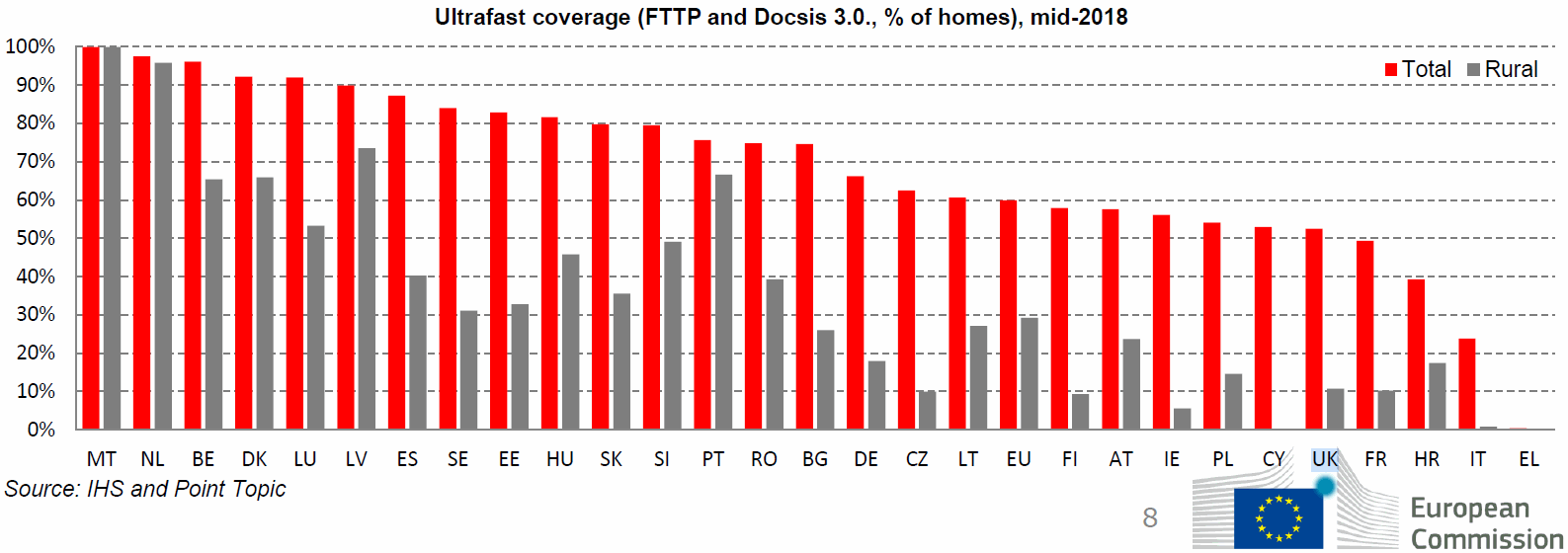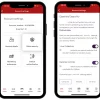UK Ranks 5th in 2019 EU Broadband Connectivity Progress Study
The European Commission has published their 2019 Digital Economy and Society Index (DESI), which uses data from 2018 to reveal how the UK’s fixed line broadband and mobile networks compare with the rest of the EU. This year we jumped in overall rank from 6th to 5th out of 28 countries but are only 10th for connectivity.
As a quick recap, back in 2010 the Digital Agenda for Europe (DAE) set several targets but the main “Connectivity” related goals called for every home to gain access to a 30Mbps+ capable Next Generation Access (NGA) broadband connection by the year 2020. On top of that it also called for 50% of consumers to be “subscribed” to a 100Mbps+ service (take-up is not the same as coverage).
A couple of years ago the EC also proposed several new, albeit non-binding, Gigabit Society targets for “all European households” to get a minimum download speed of 100Mbps+ by 2025 (must be upgradable to 1Gbps), with businesses and the public sector being told to expect 1Gbps+ (here). Suffice to say that today’s report helps to gauge the EU and UK’s progress toward achieving all of the above.
Advertisement
Overall the United Kingdom’s general rank is 5th – across all categories of the report – and that’s up from 6th in 2018. The country also continues to do well for the last generation of NGA “superfast broadband” (30Mbps+) and 4G mobile services. However, in terms of Digital Connectivity alone, the UK only ranks 10th (down from 7th last year) and we’ll explain why below.

The UK coverage of NGA style broadband networks (FTTC, FTTH, DOCSIS etc.) has increased by a single percentage point to 95% this year (compared with 83% across the EU), which puts us ahead of major economies like Germany, France, Italy and Spain but behind several other countries (e.g. Malta, Belgium, Netherlands, Ireland, Denmark and Luxembourg). We also do well for rural coverage.

Advertisement
At this point you might be wondering why our connectivity rank has dropped, particularly with the UK doing so well on NGA services. The reason for this is because it’s a different story for modern “ultrafast broadband” (100Mbps+) and “full fibre” (FTTP / FTTH) networks, where we continue to perform poorly when compared with most of the EU.
Until fairly recently the country’s largest telecoms network, Openreach (BT), was still laser focused on deploying slower hybrid-fibre (FTTC / VDSL2) upgrades (max speeds of 40-80Mbps), which are cheap and relatively quick to rollout. By comparison FTTP/H is much faster (capable of 1Gbps+ speeds) but also very expensive and slow to deploy.
As a result most of the UK’s “ultrafast” coverage has been coming from Virgin Media and their Hybrid Fibre Coax (HFC) dominated DOCSIS cable network (plus some FTTP), which only reaches a little over half of the country. By mid-2018 Openreach had only deployed a little FTTP and G.fast technology, which are both ultrafast capable solutions.
On top of that a growing number of alternative network providers (Cityfibre, Hyperoptic etc.) have been filling in a few gaps with FTTP too but by mid-2018 their coverage was still tiny. This is all well illustrated below.
Advertisement


At this point it’s worth remembering that a lot of the EU’s data is around a year out of date, which is an issue because “full fibre” (FTTP) coverage has doubled across the UK in that space of time and is continuing to ramp-up (Ofcom’s spring 2019 update put its coverage at 7%). Our ‘Summary of Full Fibre Broadband Plans‘ offers a good overview of how rapidly things are changing.
Openreach has also become much more focused upon FTTP deployments and now aims to cover 4 million UK homes and businesses with the technology by March 2021 (1.2 million have already been completed), followed by an ambition for 15 million by around 2025. After that they also have an aspiration to reach “the majority of the UK, if the right conditions to invest are in place.” Altnet ISPs have also been ramping-up their rollouts.
The Government’s Future Telecoms Infrastructure Review (FTIR) is supporting all this via a variety of changes that are designed to help foster more FTTP and 5G mobile (i.e. a 5 year holiday on business rates for new fibre, relaxed regulation / rules, investment schemes and vouchers etc.). Suffice to say that things are changing for the better but doing FTTP is still a slow process.
One potential problem area with all this FTTP progress is that it won’t shift the dial much for “ultrafast” coverage, which is simply because a lot of the full fibre networks going in the ground today are expected to overbuild Virgin Media’s existing network and that of rival FTTP providers.
EC Report Statement
In Connectivity the UK ranks 10th, above the EU average. However, while it performs well in most indicators, on ultrafast broadband coverage and take-up it lags behind. In Human capital the UK ranks sixth with a large share of people in the UK having basic digital skills or above. However, strong demand for ICT specialists on the labour market has led to supply shortages and measures put in place to combat this have not yet had a significant impact.
Elsewhere 4G Mobile (Mobile Broadband) coverage remains stuck at 98% in the UK (households), which compares with 94% across the EU (up from 91% last year). Sadly the EU does not give a figure for geographic 4G coverage as that would make for a more interesting comparison given the current debate around Government targets (here).
The Government currently hopes to see fixed “superfast broadband” networks cover around 97-98% of UK premises by the end of 2020 and they want “full fibre” services to reach “nationwide” coverage by 2033. In other words, there’s still a long way to go and the 2033 date is currently more of an aspiration that a future Government may yet tweak. Either way we’ll be lagging behind on ultrafast and FTTP for awhile yet.
One closing point to make is that there can be radical differences between countries, which makes it difficult to do any kind of apples-to-apples comparison. For example, many UK people live in individual houses but in other countries (Portugal, Spain etc.) people tend to predominantly live in apartment blocks that are easier, quicker and cheaper to connect with FTTP. Huge differences can also exist in funding and market competition structures.

The Digital Economy and Society Index 2019 (DESI)
http://ec.europa.eu/../uk-desi_2019-country-profile_eng.pdf
Mark is a professional technology writer, IT consultant and computer engineer from Dorset (England), he also founded ISPreview in 1999 and enjoys analysing the latest telecoms and broadband developments. Find me on X (Twitter), Mastodon, Facebook, BlueSky, Threads.net and Linkedin.
« Rural Stormontfield Campaign Results in Faster Wireless Broadband


















































I’m not sure that comparing countries such as Malta with the UK is useful. Malta may have better superfast coverage, but is tiny, with a relatively dense population (less dense on Gozo) of less than half a million despite the fact that it is somewhat rural. It doesn’t pose the challenges that either the large cities or the remote rural areas of the UK do.
Yes lots of differences, but then there are a fair few countries in the EU with roughly similar history and structures to UK telecoms that you can look at. Malta is at the extreme but it’s only one of 28 in that table.
The bigger issue is that many/most EU countires have more blocks of flats so wiring up for bb is very different.
Malta might be a densely populated small island. But then again, so are bigger towns in the UK, yet even there fibre broadband is rare. The UK is genuinely behind many countries in terms of fibre coverage.
How do we compare with North America?
Rural US bb is worse
Welp ¯\(°_o)/¯, a lot of us got snatched up in the Uk, when we was unemployed or underemployed couple years back, the IT sector was taking their time to employ skilled IT Brits to be honest and the creative sector too, they need to open up to Brits a lot more and other people as well that live in the uk, they waited way too late to be looking for people to fill their vacancies.